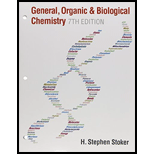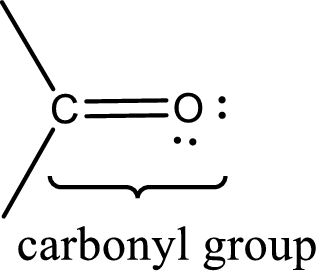
Bundle: General, Organic, and Biological Chemistry, 7th + OWLv2 Quick Prep for General Chemistry, 4 terms (24 months) Printed Access Card
7th Edition
ISBN: 9781305717534
Author: H. Stephen Stoker
Publisher: Cengage Learning
expand_more
expand_more
format_list_bulleted
Question
Chapter 15, Problem 15.118EP
(a)
Interpretation Introduction
Interpretation:
Structural formula of DMSO has to be drawn.
Concept Introduction:
Carbonyl groups are the one which contain a double bond between carbon and oxygen atom.

If either of the carbon atom or the oxygen atom present in the carbonyl group is substituted by sulfur atom means it is known as sulfur-containing carbonyl compounds.

(b)
Interpretation Introduction
Interpretation:
“Unusual” solubility properties of DMSO has to be described.
Expert Solution & Answer
Want to see the full answer?
Check out a sample textbook solution
Students have asked these similar questions
A lot of controversy surrounds the use of Aspartame as an artificial sweetener. The main argument is concerned
with the production of methanol in the body. From the structure of aspartame given below:
G0₂CH3
HẠN CH—ỆNH—CHCH,
CH, COCH
Source for the formation of methanol is,
A. ester group in the compound
B. amide group in the compound
C. carboxylic acid group in the compound
D. amino group in the compound
E. benzene ring in the compound
Which of the following statements is true?
a. Both aldehydes and ketones are easily oxidized.b. Neither aldehydes nor ketones are easily oxidized.c. Aldehydes are easily oxidized, but ketones are not.d. Ketones are easily oxidized, but aldehydes are not.
2. Which of the following is obtained by oxidizing hexanal?
a. hexanol
b. 2-hexanone
c. hexanoic acid
d. none of these
3. Which of the following oxidizing agents oxidizes aldehydes in the body?
a. NADH
b. NAD+c. O2
d. none of these
4. Which of the following will be obtained by the reaction of pentanal with H2 in the presence of a transition metal catalyst?
a. pentene
b. 1-pentanolc. 2-pentanol
d. pentanoic acid
5. The reaction of which combination of reactants result in the formation of a hemiacetal?
a. ketone and alcohol
b. ketone and aldehydec. ketone and carboxylic acid
d. none of these
What is the name of the major product formed during the reaction between berzoyl chloride and phenol?
a. phenyl benzoate
b. benzyl ester
C. cyclopentanoate
d. benzyl phenoate
e. benzenecarboxylic acid
O a
O b
O c
e
Chapter 15 Solutions
Bundle: General, Organic, and Biological Chemistry, 7th + OWLv2 Quick Prep for General Chemistry, 4 terms (24 months) Printed Access Card
Ch. 15.1 - Prob. 1QQCh. 15.1 - Prob. 2QQCh. 15.2 - Prob. 1QQCh. 15.2 - Prob. 2QQCh. 15.2 - Prob. 3QQCh. 15.3 - Prob. 1QQCh. 15.3 - Prob. 2QQCh. 15.3 - Prob. 3QQCh. 15.4 - Prob. 1QQCh. 15.4 - Prob. 2QQ
Ch. 15.4 - Prob. 3QQCh. 15.4 - Prob. 4QQCh. 15.4 - Prob. 5QQCh. 15.5 - Prob. 1QQCh. 15.5 - Prob. 2QQCh. 15.5 - Prob. 3QQCh. 15.5 - Prob. 4QQCh. 15.5 - Prob. 5QQCh. 15.6 - Prob. 1QQCh. 15.6 - Prob. 2QQCh. 15.6 - Prob. 3QQCh. 15.7 - Prob. 1QQCh. 15.7 - Prob. 2QQCh. 15.8 - Prob. 1QQCh. 15.8 - Prob. 2QQCh. 15.9 - Prob. 1QQCh. 15.9 - Prob. 2QQCh. 15.10 - Prob. 1QQCh. 15.10 - Prob. 2QQCh. 15.10 - Prob. 3QQCh. 15.10 - Prob. 4QQCh. 15.11 - Prob. 1QQCh. 15.11 - Prob. 2QQCh. 15.11 - Prob. 3QQCh. 15.11 - Prob. 4QQCh. 15.11 - Prob. 5QQCh. 15.12 - Prob. 1QQCh. 15.12 - Prob. 2QQCh. 15 - Prob. 15.1EPCh. 15 - Prob. 15.2EPCh. 15 - Prob. 15.3EPCh. 15 - In terms of polarity, which carbonyl group atom...Ch. 15 - Prob. 15.5EPCh. 15 - What is the geometrical arrangement for the atoms...Ch. 15 - Prob. 15.7EPCh. 15 - Prob. 15.8EPCh. 15 - Prob. 15.9EPCh. 15 - Prob. 15.10EPCh. 15 - Prob. 15.11EPCh. 15 - Classify each of the following structures as an...Ch. 15 - Prob. 15.13EPCh. 15 - Prob. 15.14EPCh. 15 - Prob. 15.15EPCh. 15 - Prob. 15.16EPCh. 15 - Prob. 15.17EPCh. 15 - Prob. 15.18EPCh. 15 - Prob. 15.19EPCh. 15 - Prob. 15.20EPCh. 15 - Prob. 15.21EPCh. 15 - Prob. 15.22EPCh. 15 - Prob. 15.23EPCh. 15 - Prob. 15.24EPCh. 15 - Prob. 15.25EPCh. 15 - Prob. 15.26EPCh. 15 - Prob. 15.27EPCh. 15 - Prob. 15.28EPCh. 15 - Prob. 15.29EPCh. 15 - Prob. 15.30EPCh. 15 - Prob. 15.31EPCh. 15 - Prob. 15.32EPCh. 15 - Prob. 15.33EPCh. 15 - Prob. 15.34EPCh. 15 - Prob. 15.35EPCh. 15 - Prob. 15.36EPCh. 15 - Prob. 15.37EPCh. 15 - Prob. 15.38EPCh. 15 - Prob. 15.39EPCh. 15 - Prob. 15.40EPCh. 15 - Draw a structural formula for each of the...Ch. 15 - Prob. 15.42EPCh. 15 - Prob. 15.43EPCh. 15 - Prob. 15.44EPCh. 15 - Prob. 15.45EPCh. 15 - Prob. 15.46EPCh. 15 - Prob. 15.47EPCh. 15 - Prob. 15.48EPCh. 15 - Prob. 15.49EPCh. 15 - Prob. 15.50EPCh. 15 - Prob. 15.51EPCh. 15 - Prob. 15.52EPCh. 15 - Prob. 15.53EPCh. 15 - Prob. 15.54EPCh. 15 - Prob. 15.55EPCh. 15 - Prob. 15.56EPCh. 15 - Prob. 15.57EPCh. 15 - Prob. 15.58EPCh. 15 - Prob. 15.59EPCh. 15 - Prob. 15.60EPCh. 15 - Prob. 15.61EPCh. 15 - Prob. 15.62EPCh. 15 - Prob. 15.63EPCh. 15 - Prob. 15.64EPCh. 15 - Prob. 15.65EPCh. 15 - Prob. 15.66EPCh. 15 - Prob. 15.67EPCh. 15 - Which member in each of the following pairs of...Ch. 15 - Prob. 15.69EPCh. 15 - Prob. 15.70EPCh. 15 - Prob. 15.71EPCh. 15 - Prob. 15.72EPCh. 15 - Prob. 15.73EPCh. 15 - Prob. 15.74EPCh. 15 - Prob. 15.75EPCh. 15 - Prob. 15.76EPCh. 15 - Prob. 15.77EPCh. 15 - Prob. 15.78EPCh. 15 - Prob. 15.79EPCh. 15 - What is the chemical formula of the inorganic...Ch. 15 - Prob. 15.81EPCh. 15 - Which of the following compounds would react with...Ch. 15 - Prob. 15.83EPCh. 15 - Prob. 15.84EPCh. 15 - Which of the three compounds pentanal,...Ch. 15 - Prob. 15.86EPCh. 15 - Prob. 15.87EPCh. 15 - Prob. 15.88EPCh. 15 - Prob. 15.89EPCh. 15 - Prob. 15.90EPCh. 15 - Prob. 15.91EPCh. 15 - Prob. 15.92EPCh. 15 - Which carbon atom is the hemiacetal carbon atom in...Ch. 15 - Prob. 15.94EPCh. 15 - Prob. 15.95EPCh. 15 - Prob. 15.96EPCh. 15 - Prob. 15.97EPCh. 15 - Prob. 15.98EPCh. 15 - Prob. 15.99EPCh. 15 - Prob. 15.100EPCh. 15 - Prob. 15.101EPCh. 15 - Prob. 15.102EPCh. 15 - Prob. 15.103EPCh. 15 - Prob. 15.104EPCh. 15 - Prob. 15.105EPCh. 15 - Prob. 15.106EPCh. 15 - Prob. 15.107EPCh. 15 - Prob. 15.108EPCh. 15 - Prob. 15.109EPCh. 15 - Prob. 15.110EPCh. 15 - Prob. 15.111EPCh. 15 - Prob. 15.112EPCh. 15 - Prob. 15.113EPCh. 15 - Prob. 15.114EPCh. 15 - Prob. 15.115EPCh. 15 - Prob. 15.116EPCh. 15 - Prob. 15.117EPCh. 15 - Prob. 15.118EP
Knowledge Booster
Similar questions
- What are the major products of the reaction of ethyl benzoate with hydrochloric acid and water? a. acetic acid and toluene b. phenylic acid and ethanol C. ethanoic acid and benzene d. benzoic acid and ethanol e. phenylic acid and methanol O a O barrow_forward1. Which of the following is NOT a true statement? A. Tartaric acid is present in grapes B. Acetic acid is present in sour milk C. Citric acid is a tricarboxylic acid D. Formic acid is present in insect bites 2. The greater acidity of carboxylic acids compared to alcohols arises primarily from: A. the electron-withdrawing effect of the carboxyl oxygen B. the electron-donating effect of the hydroxyl group C. the acidity of a hydrogens of carboxylic acids D. the resonance stability associated with the carboxylate ion 3. Amides are commonly prepared by reacting acyl halides, esters, or anhydrides with? A. Tertiary amines B. Ammonium hydroxide Please answer all thank you C. Ammonium chloride D. Ammoniaarrow_forward1. Which of the following structural features is possessed by aldehydes but not ketones? a. At least one hydroxyl group is bonded to the carbonyl carbon atom. b. At least one hydrogen atom is bonded to the carbonyl carbon atom. c. The carbonyl carbon atom is bonded to two other carbon atoms. d. The carbonyl carbon atom is part of a ring structure. 2. What is the IUPAC name of the following compound in the attached photo? a. 3-chloro-4-nitrobenzoic acid b. 2-chloro-4-carboxynitrobenzene c. 2-nitro-5-carboxychlorobenzene d. 2-chloro-1-nitro-4-benzoic acid 3. Which of the following is the correct bond-line structure for CH3C≡C(CH2)2CH(CH3)2? a. Structure I b. Structure II c. Structure III d. Structure IVarrow_forward
- i. Why is the boiling point of the aldehyde greater than that of the alkane? ii. Why is the boiling point of alcohol the highest? iii. Explain why the solubility of aldehydes and alcohols falls as the molecules get bigger.arrow_forwardHow can phenol be distinguished from cyclohexanol? O A. solubility in water B. solubility in hydrochloric acid solution C. solubility in sodium bicarbonate solution D. solubility in sodium hydroxide solutionarrow_forward14. PART 3: Draw the structure for compound A.arrow_forward
- 1. Give the structural formulas for both the keto and enol isomers of the following keto compounds.arrow_forwardWhat kind of solvent ingredients is usually used in the concentrations of 4-10 percent in skin care products and their function is to soften skin cells and to lessen wrinkles? A. Ethly acetate B. Alpha hydroxyl acids C. Phenols and phenol derivatives D. Aliphatic alcoholsarrow_forward1. What are the common derivatives of carboxylic acids? How are they named? 2. What reactions do carboxylic acid derivatives undergo?arrow_forward
- Which of the following compounds can react with C2H5MgBr to give 3-pentanol? a.acetone b.ethanal c.acetic acid d.ethyl formatearrow_forwardII- Chemical Reactions of Aldehydes and Ketones. 1. Draw the structural formula of the organic product when each of the following aldehydes is oxidized to carboxylic acid. a) Ethanal b) Pentanal c) Formaldehydes d) 3,4-dichlorohexanal 2. What are the characteristics of a positive Tollens test for aldehydes? 3. What is the oxidizing agent in Tollens solution? 4. What are the characteristics of a positive Benedict's test for aldehydes? 5. What is the oxidizing agent in benedict's solution?arrow_forward1. Draw the carboxylic acids formed by the oxidation of each of the following molecules. HOH₂C H2 CH3 H3CH2C H + 2. Draw the esters formed by the following reactions. a. H3C H3C-C-C H₂ H3C. OH H3C OH b. H3C H3CHCH2CH2C- རི OH + H3C. `CH2CH3 OH H₂ 3. Indicate the products of the following reaction: LCH CH3 + H₂O H3CH2CH2C CH₂OHarrow_forward
arrow_back_ios
SEE MORE QUESTIONS
arrow_forward_ios
Recommended textbooks for you
 Chemistry for Today: General, Organic, and Bioche...ChemistryISBN:9781305960060Author:Spencer L. Seager, Michael R. Slabaugh, Maren S. HansenPublisher:Cengage Learning
Chemistry for Today: General, Organic, and Bioche...ChemistryISBN:9781305960060Author:Spencer L. Seager, Michael R. Slabaugh, Maren S. HansenPublisher:Cengage Learning Organic Chemistry: A Guided InquiryChemistryISBN:9780618974122Author:Andrei StraumanisPublisher:Cengage Learning
Organic Chemistry: A Guided InquiryChemistryISBN:9780618974122Author:Andrei StraumanisPublisher:Cengage Learning

Chemistry for Today: General, Organic, and Bioche...
Chemistry
ISBN:9781305960060
Author:Spencer L. Seager, Michael R. Slabaugh, Maren S. Hansen
Publisher:Cengage Learning

Organic Chemistry: A Guided Inquiry
Chemistry
ISBN:9780618974122
Author:Andrei Straumanis
Publisher:Cengage Learning